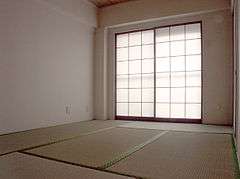Washitsu


Washitsu (和室), meaning "Japanese-style room(s)", is a Japanese term used to describe a room in a house or apartment that has traditional tatami flooring.[1] Washitsu also usually have sliding doors (fusuma), rather than hinged doors between rooms. They may have shōji and, if the particular room is meant to serve as a reception room for guests, it may have a tokonoma (alcove for decorative items).
In the past, almost all Japanese rooms were washitsu, and Japanese people slept on futons laid on the tatami and sat directly on the tatami or on zabutons set on the tatami. Nowadays, many Japanese houses have only one washitsu, which is sometimes used for entertaining guests, and most rooms are Western-style. Many new construction Japanese apartments do not have washitsu at all, instead using linoleum or hardwood floors.
The size of a washitsu is measured by the number of tatami mats, using the counter word jō (畳). Typical sizes are six or eight tatami mats in a private home. There are also half-sized mats, as in a 4.5 tatami room.
The furniture in a washitsu may include a low table at which a family may eat dinner or entertain guests, while sitting on zabuton or a low chair intended for use on tatami. A kotatsu, which is a particular type of low table that contains a heating element used in the wintertime, may also be provided; this is particularly important as most Japanese homes do not have central heating.
The antonym is yōshitsu (洋室), meaning "Western-style room(s)." Another term for washitsu is nihonma (日本間), and the corresponding term for yōshitsu is yōma (洋間).[2]
See also
References
- ↑ Washitsu (Japanese-style room) 和室 わしつ at tjf.or.jp
- ↑ Japanese Kōjien dictionary, entries for "washitsu" and "yōshitsu"
| Wikimedia Commons has media related to Traditional rooms of Japan. |